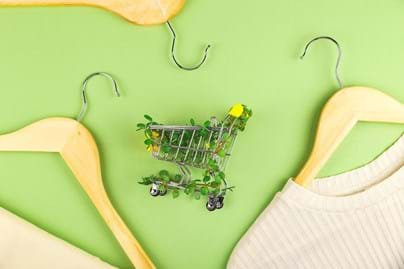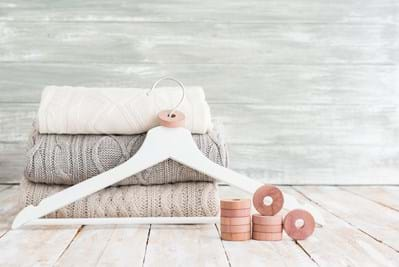“Style is the outer garb of our inner thoughts. It is the perfect marriage of what we wear and what we are.” - Dominique Loreau
What we choose to wear each day reflects our personality, style and mood. So too, should our principles and values be reflected by our wardrobe. As a strong moral compass becomes more valued in modern society, these same moral standards are also bringing into the spotlight the fashion industry.
 October 5-19 is Ethical Clothing Australia Week and what better way to jump on board this initiative than to gain a greater understanding of the impact our shopping and clothing choices have on the lives of others. Now in its third year, ECA Week is a national celebration of ethical fashion and those who are fighting for it, with in-person events being held in both NSW and Victoria as well a digital program offering online experiences.
October 5-19 is Ethical Clothing Australia Week and what better way to jump on board this initiative than to gain a greater understanding of the impact our shopping and clothing choices have on the lives of others. Now in its third year, ECA Week is a national celebration of ethical fashion and those who are fighting for it, with in-person events being held in both NSW and Victoria as well a digital program offering online experiences.
Some of the events being held include factory tours, discussion panels and specialty shopping evenings. As well as raising awareness about the flaws in the fast fashion industry, ECA Week also showcases brands which are already stepping up and demonstrating how fashion can be ethical. ECA Week was founded by Ethical Clothing Australia which is a not for profit organisation and an accreditation body which works collaboratively with local textile, clothing and footwear businesses through its accreditation program. ECA-accredited businesses are local clothing brands who must meet a strict code of practice and have been audited to ensure every step of their supply chain upholds and protects the rights and entitlements of its workers.
According to Peppermint Magazine “in Australia alone, nearly half a million skilled garment workers – 77% of them women – are employed in factories and as outworkers (working from their homes) to make the clothes we wear.” Garment workers rely on an unregulated industry for their income and often are faced with unsafe working conditions, isolation, long hours, exploitation and unstable employment. An issue made worse for non-English speaking workers who can’t easily access information about their rights. Outsider of Australia, conditions for garment workers are even worse, with most of the fashion industry supplied by production from third world countries.
Investing in ethical fashion pieces can not only help to protect the rights of others, it may also save you money in the long run. High quality, timeless items need to be replaced less frequently. Classic, stylish wardrobe staples don’t go out of fashion, so you shop less often.
 To get the most out of an ethical wardrobe and stretch your dollars even further, you might like to consider curating a capsule wardrobe to showcase your favourite ethical pieces.
To get the most out of an ethical wardrobe and stretch your dollars even further, you might like to consider curating a capsule wardrobe to showcase your favourite ethical pieces.
“Fashion changes, but style endures.” - Coco Chanel
According to Dominque Loreau, author of L’art de la Simplicite´, How to Live More with Less you only need the following items to last you a whole season:
- 7 outdoor pieces - i.e. jackets, a raincoat and a coat
- 7 tops - sweaters, shirts, tops and t-shirts
- 7 other items - trousers, jeans, skirts and dresses
- 7 pairs of shoes
- A few accessories
Undergarments, loungewear and swimwear are a separate category and aren’t included in the count, but should still be carefully considered. It might look more like a packing list for an overseas holiday, but don’t you enjoy the freedom of having coordinated outfits and fewer decisions to make when you are on vacation? A capsule wardrobe gives you that ‘holiday feel’ every day! “A dozen outfits which can be mixed and matched” may well be all you need according to Loreau, which makes it easier (and more affordable) to streamline your style sourcing from only those brands whose principles and ethics align with your own.
 For some inspiration and guidance you might like to download a mini fashion challenge by Courtney Carver, author of Project 333. Carver recommends selecting 33 items to last you for an entire season and has an online course as well as her book to guide you through the process. Carver recommends putting a pause on shopping while establishing this new way of dressing and living, especially while you are trying to figure out what you are wanting to keep in your existing wardrobe.
For some inspiration and guidance you might like to download a mini fashion challenge by Courtney Carver, author of Project 333. Carver recommends selecting 33 items to last you for an entire season and has an online course as well as her book to guide you through the process. Carver recommends putting a pause on shopping while establishing this new way of dressing and living, especially while you are trying to figure out what you are wanting to keep in your existing wardrobe.
Carver also recommends taking everything else out of your wardrobe and putting it in a box and taping it up for the next 3 months. When the following season rolls around, you have an opportunity to reflect and consider which of the 33 items you wore often and which items were ignored. You can keep as many of the existing 33 items in rotation for the following season, but be sure to swap up any season specific items (i.e. a few more warm layers or cooler layers depending on the season) to ensure a comfortable, season appropriate wardrobe.
Once you have experimented with a seasonal capsule wardrobe for 12 months, you will find yourself back at the original season you started with. If you end up choosing pretty much the same 33 items as you did the previous year, you may also discover multiple items that have been sitting in the box for 12 months. If after 12 months they still aren’t getting any airplay, it might be time to donate or sell them. In a way, this technique makes it really easy to develop a greater awareness of what you already have and what you enjoy, as well as easily observe which items you never wear because they stay in the box season after season.
 Keep your out of season clothes in sustainable and non-toxic storage by avoiding plastic tubs or synthetic fabric bags and look for natural fibre storage solutions such as sturdy canvas storage cubes, which when filled are stackable. It’s a good idea to also include some natural moth repelling solutions within your chosen storage. Cedarwood blocks, lavender flower sachets, or even cotton balls with a few drops of moth repellent specific essential oils will help to keep your clothes hole free while they await their turn to be in the spotlight.
Keep your out of season clothes in sustainable and non-toxic storage by avoiding plastic tubs or synthetic fabric bags and look for natural fibre storage solutions such as sturdy canvas storage cubes, which when filled are stackable. It’s a good idea to also include some natural moth repelling solutions within your chosen storage. Cedarwood blocks, lavender flower sachets, or even cotton balls with a few drops of moth repellent specific essential oils will help to keep your clothes hole free while they await their turn to be in the spotlight.
I’ll be honest, as someone who is actually attempting to curate my first ever seasonal capsule wardrobe (inspired by my research for this article), my list is looking closer to 40+ items with a rather stylish and extensive ‘loungewear’ selection on the side (I’m a mum of young kids who works from home, my wardrobe IS my loungewear!). I accept it’s a work in progress, but the exercise has certainly made me think about the contents of my closet. I’ve enjoyed identifying favourite pieces, finding coordinating items and choosing a style to stick with for a few months. I’ve taken note of which items were purchased second hand (and therefore ethical), handmade by the maker (such as from Etsy makers or market purchases, and therefore ethical) and those items I bought in department stores or online and which were most likely a product of unethical production. I’m not going to inflict myself with a barrage of guilt, but with awareness comes responsibility and the intention of making informed choices in the future.
As one of the least regulated industries in the world, there is plenty of space for the fashion industry to be improved and regulations implemented. If we can begin to educate ourselves about how our clothes are made, we can then make more conscious decisions about where to source them. When buying new items seek out locally made ethical brands such as these ECA accredited brands.
Like all consumer purchases, we have the power to make an impact. Research and lobby your favourite brands and support those who are committed to making a difference in the industry. Invest in high quality items, look after them and cherish them. Choose natural fibres and classic styles which will outlive passing trends. Curate a capsule wardrobe of clothes which make you feel good about yourself instead of an overcrowded closet of low-quality impulse buys. Less really IS more in the case of a seasonal wardrobe. And think of all the time you’ll save getting dressed each morning!

Alison Gallagher is a freelance writer, resourcefulness expert and entrepreneur. She has been featured in various publications including Stellar Magazine, Australian Health and Fitness Magazine, and Cleo Magazine. Alison is particularly passionate about sharing practical tips on how to live simply, sustainably and seasonally.






